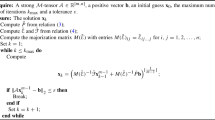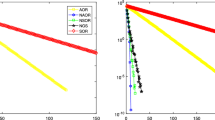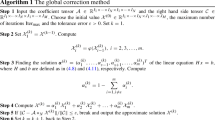Abstract
In tensor computations, tensor–vector multiplication is one of the main computational costs. We recently studied algorithms with wider applicability and more computational potential for computing the largest eigenpair of a weakly irreducible nonnegative mth-order tensor \({\mathscr {A}}\), called higher-order Noda iteration (HONI). This method is an eigenvalue solver which uses an inner-outer scheme. The outer iteration is the update of the approximate eigenpair(s), while in the inner iteration a multilinear system has to be solved, often iteratively. For the inner iteration, we also provide a Newton-type method to solve multilinear systems, and prove that the algorithm converges to the unique solution of multilinear systems and the convergence rate is quadratic. HONI has superior performance in terms of fast convergence and positivity preserving property, and its main advantage is to use simple recursive relations to compute the approximate eigenvalue, which means that no additional tensor–vector multiplication is required. Moreover, we devise a practical relaxation criterion based on our theoretical results to improve the efficiency and practicality of HONI, called inexact HONI, and further explain the relationship between HONI and Newton–Noda iteration. Numerical experiments are provided to support the theoretical results.




Similar content being viewed by others
References
Berman, A., Plemmons, R.J.: Nonnegative Matrices in the Mathematical Sciences. SIAM, Philadelphia (1994)
Chang, K.-C., Pearson, K.J., Zhang, T.: Primitivity, the convergence of the NQZ method, and the largest eigenvalue for nonnegative tensors. SIAM J. Matrix Anal. Appl. 32, 806–819 (2011)
Chang, K.C., Pearson, K., Zhang, T.: Perron–Frobenius theorem for nonnegative tensors. Commun. Math. Sci. 6, 507–520 (2008)
Ching, W., Ng, M.: Markov Chains: Models, Algorithms and Applications. International Series in Operations Research and Management Science. Springer, New York (2006)
Cooper, J., Dutle, A.: Spectra of uniform hypergraphs. Linear Algebra Appl. 436, 3268–3292 (2012)
Ding, W., Wei, Y.: Solving multi-linear systems with M-tensors. J. Sci. Comput. 68, 689–715 (2016)
Friedland, S., Gaubert, S., Han, L.: Perron–Frobenius theorem for nonnegative multilinear forms and extensions. Linear Algebra Appl. 438, 738–749 (2013)
Han, L.: A homotopy method for solving multilinear systems with M-tensors. Appl. Math. Lett. 69, 49–54 (2017)
He, H., Ling, C., Qi, L., Zhou, G.: A globally and quadratically convergent algorithm for solving multilinear systems with M-tensors. J. Sci. Comput. 76, 1718–1741 (2018)
Hu, S., Huang, Z.-H., Qi, L.: Finding the spectral radius of a nonnegative tensor (2011). http://arxiv.org/pdf/1111.2138v1
Hu, S., Qi, L.: The Laplacian of a uniform hypergraph. J. Comb. Optim. 29, 331–366 (2015)
Hu, S., Qi, L., Xie, J.: The largest Laplacian and signless Laplacian \(H\)-eigenvalues of a uniform hypergraph. Linear Algebra Appl. 469, 1–27 (2015)
Kolda, T.G., Bader, B.W.: Tensor decompositions and applications. SIAM Rev. 51, 455–500 (2009)
Liu, C.-S., Guo, C.-H., Lin, W.-W.: A positivity preserving inverse iteration for finding the Perron pair of an irreducible nonnegative third order tensor. SIAM J. Matrix Anal. Appl. 37, 911–932 (2016)
Liu, C.-S., Guo, C.-H., Lin, W.-W.: Newton–Noda iteration for finding the Perron pair of a weakly irreducible nonnegative tensor. Numer. Math. 137, 63–90 (2017)
Li, D., Xie, S., Xu, H.: Splitting methods for tensor equations. Numer. Linear Algebra 24, 1–6 (2017)
Lv, C., Ma, C.: A Levenberg–Marquardt method for solving semi-symmetric tensor equations. J. Comput. Appl. Math. 332, 13–25 (2018)
Ni, Q., Qi, L.: A quadratically convergent algorithm for finding the largest eigenvalue of a nonnegative homogeneous polynomial map. J. Glob. Optim. 61, 627–641 (2015)
Ng, M., Qi, L., Zhou, G.: Finding the largest eigenvalue of a nonnegative tensor. SIAM J. Matrix Anal. Appl. 31, 1090–1099 (2009)
Noda, T.: Note on the computation of the maximal eigenvalue of a non-negative irreducible matrix. Numer. Math. 17, 382–386 (1971)
Pearson, K.J.: Essentially positive tensors. Int. J. Algebra 4, 421–427 (2010)
Raftery, A.E.: A model of high-order Markov chains. J. R. Stat. Soc. Ser. B 47, 528–539 (1985)
Wang, X., Che, M., Wei, Y.: Neural networks based approach solving multi-linear systems with M-tensors. Neurocomputing 351, 33–42 (2019)
Xie, Z., Jin, X., Wei, Y.: Tensor methods for solving symmetric M-tensor. J. Sci. Comput. 74, 412–425 (2018)
Yang, Y., Yang, Q.: On some properties of nonnegative weakly irreducible tensors (2011). arXiv:1111.0713v2
Yang, Y., Yang, Q.: Further results for Perron–Frobenius Theorem for nonnegative tensors. SIAM J. Matrix Anal. Appl. 31, 2517–2530 (2010)
Zhang, L., Qi, L.: Linear convergence of an algorithm for computing the largest eigenvalue of a nonnegative tensor. Numer. Linear Algebra Appl. 19, 830–841 (2012)
Zhang, L., Qi, L., Zhou, G.: M-tensors and some applications. SIAM J. Matrix Anal. Appl. 35, 437–452 (2014)
Acknowledgements
I would like to thank the anonymous referees for their valuable comments. This work is supported by Ministry of Science and Technology in Taiwan.
Author information
Authors and Affiliations
Corresponding author
Additional information
Publisher's Note
Springer Nature remains neutral with regard to jurisdictional claims in published maps and institutional affiliations.
Rights and permissions
About this article
Cite this article
Liu, CS. Exact and Inexact Iterative Methods for Finding the Largest Eigenpair of a Weakly Irreducible Nonnegative Tensor. J Sci Comput 91, 78 (2022). https://doi.org/10.1007/s10915-022-01852-5
Received:
Revised:
Accepted:
Published:
DOI: https://doi.org/10.1007/s10915-022-01852-5
Keywords
- Inner–outer iteration
- Nonnegative tensor
- M-matrix
- Higher-order Noda iteration
- Positivity preserving
- Quadratic convergence
- Perron vector




